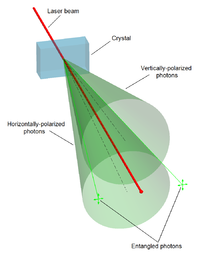
Photo from wikipedia
Genuine high-dimensional entanglement, i.e., the property of having a high Schmidt number, constitutes an instrumental resource in quantum communication, overcoming limitations of low-dimensional systems. States with a positive partial transpose… Click to show full abstract
Genuine high-dimensional entanglement, i.e., the property of having a high Schmidt number, constitutes an instrumental resource in quantum communication, overcoming limitations of low-dimensional systems. States with a positive partial transpose (PPT) are generally considered weakly entangled, as they can never be distilled into pure entangled states. This naturally raises the question of whether high Schmidt numbers are possible for PPT states. Volume estimates suggest that optimal, i.e., linear, scaling in the local dimension should be possible, albeit without providing insight into the possible slope. We provide the first explicit construction of a family of PPT states that achieves linear scaling in the local dimension and we prove that random PPT states typically share this feature. Our construction also allows us to prove a recent conjecture of Chen et al. on the existence of PPT states whose Schmidt number increases by an arbitrarily large amount upon partial transposition. Finally, we link the Schmidt number to entangled sub-block matrices of a quantum state. We use this connection to prove that quantum states that are either (i) invariant under partial transposition on the smallest of their two subsystems, or (ii) absolutely PPT cannot have a maximal Schmidt number. Overall, our findings shed new light on some fundamental problems in entanglement theory.
Journal Title: Physical review letters
Year Published: 2018
Link to full text (if available)
Share on Social Media: Sign Up to like & get
recommendations!